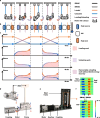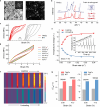Efficient roller-driven elastocaloric refrigerator
- PMID: 39169046
- PMCID: PMC11339461
- DOI: 10.1038/s41467-024-51632-y
Efficient roller-driven elastocaloric refrigerator
Abstract
Elastocaloric cooling has experienced fast development over the past decade owing to its potential to reshape the refrigeration industry. While the solid-state elastocaloric refrigerant is emission-free, the efficiency of the state-of-the-art elastocaloric cooling systems is not sufficient yet to reduce carbon emissions during operation. In this study, we double the coefficient of performance, the most commonly used efficiency metric, via the synergy of material-level advances in TiNiCu and the system-level roller-driven mechanism capable of recovering kinetic energy. On the materials level, a 125% improvement in coefficient of performance is illustrated in TiNiCu compared to NiTi, empowered by the B2-B19 martensitic transformation with improved lattice compatibility and the grain boundary strengthening from the nanocrystalline structure. On the system level, owing to the properly sized angular momentum in rotating parts, 78% work recovery efficiency is reported, transcending the theoretical limit previously unattainable without kinetic energy recovery. This confluence of materials and mechanical innovations propels elastocaloric cooling systems into a new realm of efficiency and paves the way for their practical application.
© 2024. The Author(s).
Conflict of interest statement
The authors declare no competing interests.
Figures





References
-
- UNEP. Global Cooling Watch 2023: Keeping it Chill. https://wedocs.unep.org/handle/20.500.11822/44243 (2023).
-
- Dupont, J. L., Domanski, P. A., Lebrun, P. & Ziegler, F. The Role of Refrigeration in the Global Economy. https://iifiir.org/en/fridoc/142028 (2019).
-
- OECD Library. The Future of Cooling, Vol. 92 (International Energy Agency, 2018).
-
- Woods, J. et al. Humidity’s impact on greenhouse gas emissions from air conditioning. Joule6, 726–741 (2022).10.1016/j.joule.2022.02.013 - DOI
-
- Kitanovski, A. Energy applications of magnetocaloric materials. Adv. Energy Mater.10, 1903741 (2020).10.1002/aenm.201903741 - DOI
Grants and funding
LinkOut - more resources
Full Text Sources
Miscellaneous

